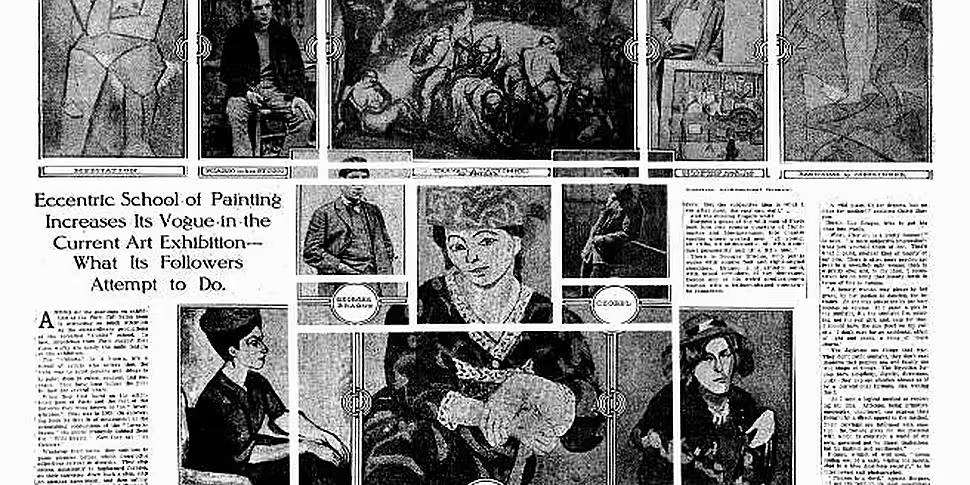In the second 'History of Art Night School' Patrick and Dr Francis Halsall look at Cubism, its impact on art, and its role in the modern world.
How did this movement come about? Did Cubism offer a new way of representing time and space? How does Cubism reflect the modern world of mass production, the motor car, and photographs? Is Pablo Picasso the most influential artist of the 20th century? And can we take his claim that Cubism is an art of Realism seriously?
Join Patrick and Francis as they look at Cubism and its abstract representations of the real world.
 ‘Les Demoiselles d'Avignon’ (The Young Ladies of Avignon) by Pablo Picasso, 1907: oil on canvas, Museum of Modern Art, New York.
‘Les Demoiselles d'Avignon’ (The Young Ladies of Avignon) by Pablo Picasso, 1907: oil on canvas, Museum of Modern Art, New York.
 ‘L'Usine, Horta de Ebro’ (Brick Factory at Tortosa) by Pablo Picasso, 1909: oil on canvas, State Hermitage Museum, Saint Petersburg.
‘L'Usine, Horta de Ebro’ (Brick Factory at Tortosa) by Pablo Picasso, 1909: oil on canvas, State Hermitage Museum, Saint Petersburg.
 ‘Nu descendant un escalier n° 2’ (Nude Descending a Staircase, No. 2) by Marcel Duchamp, 1912.
‘Nu descendant un escalier n° 2’ (Nude Descending a Staircase, No. 2) by Marcel Duchamp, 1912.
 ‘Violon et palette’ (Violin and Palette) by Georges Braque, 1909: oil on canvas, Solomon R. Guggenheim Museum, New York.
‘Violon et palette’ (Violin and Palette) by Georges Braque, 1909: oil on canvas, Solomon R. Guggenheim Museum, New York.
 ‘Guitar, Sheet Music and Glass’ by Pablo Picasso, 1912: Papers and pasted newsprint, gouache and charcoal on paper McNay Art Museum, San Antonio, TX.
‘Guitar, Sheet Music and Glass’ by Pablo Picasso, 1912: Papers and pasted newsprint, gouache and charcoal on paper McNay Art Museum, San Antonio, TX.
 ‘Lucky Strike’ by Stuart Davis, 1921: Oil on Canvas, Museum of Modern Art, New York.
‘Lucky Strike’ by Stuart Davis, 1921: Oil on Canvas, Museum of Modern Art, New York.



 ‘Les Demoiselles d'Avignon’ (The Young Ladies of Avignon) by Pablo Picasso, 1907: oil on canvas, Museum of Modern Art, New York.
‘Les Demoiselles d'Avignon’ (The Young Ladies of Avignon) by Pablo Picasso, 1907: oil on canvas, Museum of Modern Art, New York. ‘L'Usine, Horta de Ebro’ (Brick Factory at Tortosa) by Pablo Picasso, 1909: oil on canvas, State Hermitage Museum, Saint Petersburg.
‘L'Usine, Horta de Ebro’ (Brick Factory at Tortosa) by Pablo Picasso, 1909: oil on canvas, State Hermitage Museum, Saint Petersburg. ‘Nu descendant un escalier n° 2’ (Nude Descending a Staircase, No. 2) by
‘Nu descendant un escalier n° 2’ (Nude Descending a Staircase, No. 2) by  ‘Violon et palette’ (Violin and Palette) by Georges Braque, 1909: oil on canvas, Solomon R. Guggenheim Museum, New York.
‘Violon et palette’ (Violin and Palette) by Georges Braque, 1909: oil on canvas, Solomon R. Guggenheim Museum, New York. ‘Guitar, Sheet Music and Glass’ by Pablo Picasso, 1912: Papers and pasted newsprint, gouache and charcoal on paper McNay Art Museum, San Antonio, TX.
‘Guitar, Sheet Music and Glass’ by Pablo Picasso, 1912: Papers and pasted newsprint, gouache and charcoal on paper McNay Art Museum, San Antonio, TX. ‘Lucky Strike’ by Stuart Davis, 1921: Oil on Canvas, Museum of Modern Art, New York.
‘Lucky Strike’ by Stuart Davis, 1921: Oil on Canvas, Museum of Modern Art, New York.





